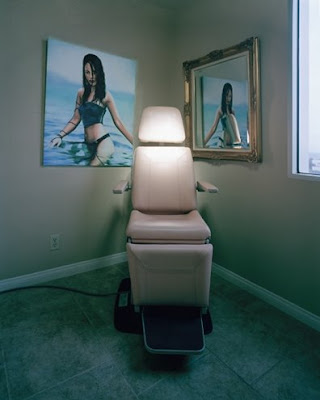 (Cara Phillips)
(Cara Phillips)While I was away from the blog (and away from the computer most of the time), one thing I did keep an eye on was the irregular newsletter from Photoeye with their "New Arrivals" at the bookstore.
There were a good few books that looked quite intriguing, but it was also a little depressing to see the steady stream of derivatives - either ion style or content (or both), as well as the increase in the number of exotic documentary/documentary style books - that is, take a style - such as 1930's or 1970's documentary photography, or 1980's British Colour - and then photograph somewhere that the homebody photo-critics are unlikely to have been. So we get this sort of treatment of say South Africa, or Brazil or the far North. And everyone ooo's and ahhh's - basically a sort of suburban National Geographic in the mailbox response.
 (from Fig.)
(from Fig.)Mind you, the Photoeye intro on their website for the new Jeff Wall book almost made we want to go out and buy it for the description alone: Jeff Wall "Standing almost 14 inches wide by 20 inches tall...". All I could think was - heck - he must be a really funny looking little bugger - how does he reach the ground glass?
Anyway, onto a few book (and one DVD) from 2008 that are worth an extended view. In no particular order (okay, my favourite is first):
- Fig. by Broomberg & Chanarin. A completley and utterly intriguing book also reviewed on 5b4. Photography for the 21st Century.
 (from Fig.)
(from Fig.)- Putting Back the Wall by John Gossage. The completion (I think?) of his Berlin opus. One of the few photographers around really doing b&w photography (as well as incredible book producer? designer? maker?). I can spend ages looking through his books.
 (John Gossage)
(John Gossage)- Silicon Valley by Gabrielle Basilico. I like Basilico's first real look at the USA - as well as an extended use of colour alongside his masterful b&w. (btw, his Cityscapes has just been republished - at least I think it's a retread. Either way, it's a great way to be overwhelmed by a large selection - 400pp - from his different projects)
2.jpg) (Gabrielle Basilico)
(Gabrielle Basilico)- Strange and Singular by Michael Abrams. Another fascinating book from Loostrife Books (Gossage and friends). I'm even more fascinated by archival and vernacular photographs these days than ever. Abrams selection/juxtaposition of photographs and texts is spot on and something I keep going back to. This book actually lives at work along my other reference books on archives and archival theory. Oh - and the free photos that come loose with it are a nice touch. I'll write a bit more about Strange and SIngular in another post

- There is also a third book from Loostrife that I think makes the cut, but I didn't get around to really looking at it before I was knocked off my feet for the last few months, so I'll save it for later: Waiting, Sitting, Fishing and Some Automobiles by Anthony Hernandez (review at 5b4)
- Not an individual book but a whole series. And I haven't actually seen any yet but the Books on Books republishing by Errata Editions, brought to us by Jeffrey Ladd of 5b4. So far they have republished books by Atget, Walker Evans, Chris Killip and Sophie Ristelhueber. I'm lucky enough to own thee out of their first four books (only the Killip is a first edition though...) . Unfortunately they still temp me because the essays look good... And I haven't yet even got around to reading Jeff's blogging on 5b4 on the fun of being on-press in China for the printing.

- Luigi Ghirri: It's Beautiful Here, Isn't It... For the longest time there was no good book avaialble on the work of Luigi Ghirri. Ghirri is recognised as one of the important originators and practitioners of the whole New Color thing that still holds sway in todays world of contemporary photogrpahy. This book reinforces that idea that there is nothing new under the sun. Take almost any of the hip, new, cutting edge and much lauded trends in colour photogrpahy over the last say eight to ten years and you'll realise Ghirri was doing most of it in thw 1978's and early 1980's.
 (Luigi Ghirri)
(Luigi Ghirri)- Lastly, a DVD. While I was taking some time resting over the summer, I took a copy What Remains: The Life and Work of Sally Mann . I've always been drawn to Mann's Work and despite being a "straightforward" sort of film documentary, it is full of strangeness. If the insight the film gives is corrext, Sally Mann is as strange and disquieting and peculiar as her work - thank goodness.

(Cara Phillips)
(P.S. - oh - and negative kudos and curses on the book shops where I had an order in last year for Paul Graham's A Shimmer of Possibility. Even though I ordered well before publication I never got a copy. You know who you are... a pox on you all :-) )














































